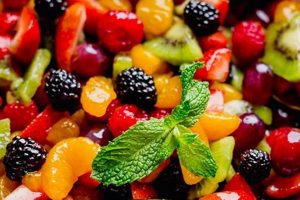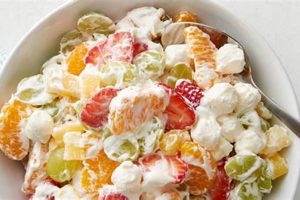A molded dessert featuring a combination of fruits suspended in a gelatin matrix is a popular, refreshing treat. This dish often incorporates canned or fresh fruits, and the gelatin can be flavored to complement the fruit selection, such as lemon, lime, or orange. A classic example might include diced peaches, pears, grapes, and pineapple in a lemon-flavored gelatin.
This type of dessert offers a balance of flavor, texture, and visual appeal. The jiggly consistency of the gelatin contrasts with the varied textures of the fruit, creating a sensory experience. It’s also a convenient make-ahead dish, suitable for potlucks, picnics, and holidays. Historically, gelatin-based desserts gained popularity in the early 20th century as refrigeration became more commonplace, allowing for the easy setting of these dishes. They offered a relatively inexpensive and visually appealing way to incorporate fruit into a dessert.
This article will explore various aspects of creating these delightful desserts, including selecting appropriate fruits, flavor pairings, tips for achieving the perfect gelatin consistency, and creative presentation ideas.
Tips for Creating the Perfect Fruit-Gelatin Dessert
Achieving optimal results with gelatin-based fruit desserts requires attention to detail and a few key techniques. The following tips offer guidance for a successful outcome.
Tip 1: Fruit Selection is Key: Opt for fruits that hold their shape and texture well within the gelatin. Berries, grapes, diced melon, and canned fruits such as peaches, pears, and pineapple are excellent choices. Avoid fruits like fresh kiwi and papaya, which contain enzymes that prevent gelatin from setting properly.
Tip 2: Balancing Flavor Profiles: Consider the flavor compatibility of the chosen fruits and the gelatin flavor. Citrus-flavored gelatin pairs well with a variety of fruits, while berry-flavored gelatin complements berries and other sweet fruits.
Tip 3: Layering for Visual Appeal: Create a visually stunning dessert by layering fruits and gelatin. Allow each layer to set partially before adding the next, preventing the fruits from sinking to the bottom.
Tip 4: Achieving Optimal Gelatin Consistency: Follow package instructions carefully for dissolving the gelatin. Ensure complete dissolution before adding the fruit to prevent a grainy texture. Chilling times may vary based on the recipe and the type of gelatin used.
Tip 5: Mold Preparation for Easy Removal: Lightly grease the mold with a neutral oil or cooking spray before adding the gelatin mixture. This ensures effortless release of the dessert once it has set.
Tip 6: Garnishing for an Elegant Touch: Enhance the presentation with a simple garnish. Fresh mint leaves, whipped cream, or a sprinkle of toasted nuts can elevate the visual appeal.
Tip 7: Storage for Maintaining Freshness: Store the finished dessert in the refrigerator, covered, to maintain its freshness and prevent it from drying out.
By following these tips, one can create a visually appealing and flavorful dessert suitable for any occasion. These techniques ensure the proper texture and consistency of the gelatin, maximizing the enjoyment of the combined flavors.
This exploration of techniques and tips provides a foundation for creating successful fruit-gelatin desserts. The following section offers several recipe variations to further inspire culinary creativity.
1. Fruit Selection
Fruit selection is paramount in crafting a successful fruit-gelatin dessert. The choice of fruit significantly impacts the final product’s flavor, texture, and visual appeal. Careful consideration of fruit characteristics ensures a harmonious blend of elements within the gelatin matrix.
- Fruit Firmness and Texture:
Fruits that maintain their structure after being submerged in liquid are ideal. Softer fruits may break down, resulting in a less appealing presentation and potentially cloudy gelatin. Examples of suitable fruits include grapes, berries, and diced melon. Conversely, overripe or bruised fruit should be avoided due to their compromised texture and potential to negatively impact the overall flavor.
- Flavor Compatibility:
The chosen fruit flavors should complement the selected gelatin flavor. Consider the sweetness and tartness of both the fruit and the gelatin. For instance, a tart lemon-flavored gelatin pairs well with sweet fruits like berries and grapes, while a sweeter gelatin might benefit from the inclusion of slightly tart fruits such as pineapple or mandarin oranges. Balancing these flavors ensures a harmonious and palatable dessert.
- Visual Appeal and Color Variety:
A visually appealing fruit salad incorporates a variety of colors and shapes. Consider using a mix of colors, such as red berries, green grapes, and yellow pineapple, to create a vibrant presentation. Varying the shapes of the fruit pieces adds visual interest. For example, combining whole grapes with diced melon and sliced strawberries offers a more dynamic look than using uniformly diced fruit.
- Enzymatic Activity Considerations:
Certain fruits, such as fresh pineapple, kiwi, and papaya, contain enzymes that break down proteins, including gelatin. These fruits can prevent the gelatin from setting properly. If these fruits are desired, they should be briefly cooked or canned varieties should be used, as the heating process deactivates these enzymes. Understanding this aspect of fruit selection is crucial for achieving the desired gelatin consistency.
By carefully considering these facets of fruit selection, one can ensure a visually appealing, flavorful, and texturally satisfying fruit-gelatin dessert. The interplay of fruit characteristics contributes significantly to the overall success of the dish.
2. Jello Flavor Pairing
Jello flavor pairing plays a crucial role in the overall success of a fruit salad jello recipe. The chosen jello flavor significantly influences the final taste and how well it complements the incorporated fruits. Compatibility between fruit and jello flavors is essential for a balanced and palatable dessert. A mismatch can lead to a clash of flavors, diminishing the enjoyment of the dish. For example, a robust, cherry-flavored jello might overwhelm delicate fruits like berries, while a light, lemon-flavored jello could be overpowered by strong-flavored fruits like pineapple. Therefore, careful consideration of flavor profiles is necessary.
Understanding the interplay between fruit acidity and jello sweetness is key to successful flavor pairing. Tart fruits often pair well with sweeter jello flavors, creating a balanced taste. Conversely, sweet fruits can benefit from the tartness of certain jello flavors. Consider a lime-flavored jello with a mix of sweet berries and melon. The tartness of the lime enhances the sweetness of the fruit, while the fruit sweetness tempers the lime’s tartness. Similarly, a sweeter orange-flavored jello can be balanced with the slight acidity of mandarin orange segments and pineapple chunks. These combinations exemplify the practical significance of flavor pairing in enhancing the overall taste experience.
Successful jello flavor pairing elevates fruit salad jello from a simple combination of ingredients to a cohesive and flavorful dessert. Challenges may arise when incorporating a wide variety of fruits, requiring a versatile jello flavor that complements all components. In such cases, neutral jello flavors or complementary flavor combinations are often employed. Mastering the art of jello flavor pairing contributes significantly to achieving a balanced, harmonious, and ultimately enjoyable fruit salad jello creation. This understanding enhances recipe development and allows for creative exploration of flavor profiles within the fruit-gelatin dessert realm.
3. Mold preparation
Mold preparation is a crucial step in crafting visually appealing and easily servable fruit salad jello. Proper preparation ensures the structural integrity of the dessert and facilitates clean removal from the mold, preserving its aesthetic presentation. Overlooking this step can lead to difficulties in unmolding, potentially damaging the dessert and diminishing its visual appeal. The following facets highlight the key considerations in mold preparation for fruit salad jello.
- Mold Material and Shape:
Various materials, including glass, metal, and plastic, can be used for molding fruit salad jello. Each material possesses different properties that influence the unmolding process. Glass and metal molds often require a light greasing or lining with parchment paper to prevent sticking. Some plastic molds may offer a non-stick surface, eliminating the need for greasing. The chosen shape of the mold contributes to the final presentation. Bundt pans create elegant, fluted desserts, while loaf pans offer a classic, rectangular shape. The mold’s size should also be considered in relation to the desired serving size and quantity.
- Preventing Sticking:
Preventing the jello from adhering to the mold is essential for clean removal. Several techniques can be employed to achieve this. Lightly greasing the mold’s interior surface with a neutral-flavored oil or cooking spray creates a barrier between the jello and the mold. Alternatively, lining the mold with parchment paper, ensuring it extends beyond the mold’s edges, allows for easy lifting of the set jello. These methods ensure a smooth unmolding process and preserve the dessert’s shape.
- Temperature Considerations:
Temperature plays a significant role in the setting process of the jello and its subsequent release from the mold. Pouring the jello mixture into a room-temperature mold promotes even setting and reduces the risk of air bubbles forming along the edges. Chilling the mold briefly before adding the jello mixture can also facilitate a smoother setting process, particularly in warmer environments. These temperature considerations contribute to the overall structural integrity and ease of unmolding.
- Unmolding Techniques:
Once the jello has fully set, careful unmolding techniques are necessary to preserve its shape. Dipping the mold briefly into warm water can loosen the jello from the mold’s edges, facilitating release. Alternatively, gently running a thin knife or spatula around the edges of the mold can break the seal between the jello and the mold. Inverting the mold onto a serving plate and gently shaking it can release the jello. Patience and a gentle approach are key to preventing damage during the unmolding process.
Careful mold preparation contributes significantly to the final presentation and ease of serving fruit salad jello. A well-prepared mold ensures the dessert maintains its intended shape and releases cleanly, enhancing the visual appeal and overall dining experience. Understanding the nuances of mold material, preventing sticking, temperature considerations, and unmolding techniques allows for consistent and successful results in creating visually stunning and enjoyable fruit salad jello desserts.
4. Chilling Time
Chilling time is a critical factor in the successful preparation of fruit salad jello. Adequate chilling allows the gelatin to solidify completely, creating the desired texture and structural integrity. Insufficient chilling results in a weak, unstable structure, potentially leading to a less visually appealing and difficult-to-serve dessert. Conversely, excessive chilling can make the jello too firm, affecting its palatability. The relationship between chilling time and the final product’s quality is demonstrably significant. For instance, a recipe requiring a four-hour chilling period will yield a different result if chilled for only two hours or for six. The four-hour mark represents the optimal setting point for that specific recipe, balancing firmness with desired texture. This illustrates the cause-and-effect relationship between chilling time and the final product.
The importance of chilling time as a component of fruit salad jello recipes stems from the nature of gelatin itself. Gelatin requires a specific temperature range to activate and form a stable gel. This temperature-dependent process directly influences the texture and consistency of the finished product. Understanding this principle allows for predictable control over the outcome. Practical applications of this understanding include adjusting chilling times based on ambient temperature and desired firmness. In warmer environments, longer chilling times may be necessary to achieve the same level of firmness as in cooler environments. Similarly, if a firmer texture is desired, the chilling time can be extended, while a softer texture can be achieved with a shorter chilling time, within the recipe’s recommended range.
Chilling time, therefore, is not merely a passive waiting period but an active component in the formation of fruit salad jello. It represents a crucial stage where the dessert’s structural integrity and textural properties are defined. Mastery of chilling time, informed by an understanding of gelatin’s temperature-dependent behavior, enables predictable and desirable outcomes. Challenges may arise when balancing chilling time with other recipe components, such as the use of certain fruits that may affect setting time. However, careful consideration of these factors, combined with practical experience, allows for successful navigation of such challenges, ultimately contributing to the creation of a perfectly set and enjoyable fruit salad jello dessert.
5. Serving Suggestions
Serving suggestions enhance the presentation and enjoyment of fruit salad jello, elevating it from a simple dish to a more sophisticated dessert. Consideration of serving suggestions demonstrates attention to detail and an understanding of how presentation contributes to the overall dining experience. These suggestions offer a framework for showcasing the dessert’s visual appeal and complementing its flavor profile. Exploring various serving techniques allows for creative expression and customization based on the specific occasion and audience.
- Portioning and Plating:
Portioning influences perceived value and practicality. Individual servings in elegant glassware, such as stemmed dessert cups or small bowls, create a refined presentation suitable for formal occasions. Alternatively, a larger, shareable mold serves well for casual gatherings. Plating techniques further enhance visual appeal. Garnishes like fresh mint sprigs or a dollop of whipped cream add a touch of elegance. The plate itself should complement the dessert’s colors and textures. For instance, a white plate provides a clean backdrop for vibrant jello colors, while a textured plate adds visual interest.
- Accompaniments and Pairings:
Accompaniments can complement or contrast the jello’s flavors and textures. A light, airy accompaniment, such as whipped cream or a scoop of vanilla ice cream, contrasts with the jello’s jiggly texture. A drizzle of custard or a sprinkle of toasted nuts adds complementary flavors and textures. Beverage pairings further enhance the dining experience. A chilled glass of sparkling wine or a fruit-infused iced tea complements the fruit flavors in the jello. The choice of accompaniment should harmonize with the overall flavor profile of the dessert.
- Contextual Considerations:
Serving suggestions should align with the specific occasion. A formal dinner party might call for individual servings with elegant garnishes, while a casual picnic might warrant a simpler, family-style presentation. Seasonal considerations also play a role. A refreshing, chilled jello is ideal for summer, while a spiced jello with warm accompaniments suits cooler months. The context informs the choice of serving style and accompaniments, creating a cohesive and appropriate presentation.
- Dietary Adaptations:
Dietary restrictions should be considered when offering serving suggestions. For those avoiding dairy, whipped cream can be replaced with coconut whipped cream or a fruit coulis. Sugar-free jello and fresh fruit cater to those limiting sugar intake. Offering a variety of accompaniments allows guests to customize their dessert based on individual preferences and dietary needs. This inclusivity ensures everyone can enjoy the dessert.
Thoughtful serving suggestions elevate fruit salad jello from a simple dessert to a memorable culinary experience. These suggestions, encompassing portioning, accompaniments, contextual considerations, and dietary adaptations, demonstrate an understanding of how presentation and customization contribute to overall enjoyment. By implementing these strategies, one can transform a basic fruit salad jello recipe into a visually appealing and satisfying dessert appropriate for a variety of occasions and palates.
Frequently Asked Questions
This section addresses common inquiries regarding the preparation and variations of fruit-gelatin desserts.
Question 1: Can fresh pineapple be used in gelatin desserts?
Fresh pineapple contains an enzyme called bromelain, which prevents gelatin from setting. Canned pineapple, however, is treated with heat, deactivating bromelain, making it suitable for use.
Question 2: How can cloudiness in the finished gelatin be avoided?
Cloudiness can result from undissolved gelatin or incorporating certain fruits. Ensuring the gelatin dissolves completely before adding fruit and avoiding fruits known to cloud gelatin, such as bananas, helps maintain clarity. Additionally, straining the mixture can remove any particulate matter.
Question 3: What are suitable alternatives to traditional gelatin?
Vegetarian alternatives, such as agar-agar, derived from seaweed, offer similar gelling properties and can be used as a substitute.
Question 4: How can the sweetness of the dessert be adjusted?
Sweetness can be adjusted by using sugar-free gelatin or by adding a small amount of sweetener or sugar to the gelatin mixture before chilling. The sweetness of the incorporated fruits also contributes to the overall sweetness level.
Question 5: How long can a prepared gelatin dessert be stored?
Properly stored, covered in the refrigerator, these desserts typically last for several days. However, the freshness of the incorporated fruit can influence overall shelf life. Observe the fruit for signs of spoilage.
Question 6: How can one ensure a smooth, even texture in the finished gelatin?
Ensuring complete dissolution of the gelatin granules before adding other ingredients is crucial for a smooth texture. Whisking the mixture thoroughly after heating and before chilling helps prevent graininess and promotes even distribution of the fruit.
Understanding these frequently addressed questions allows for greater control over the outcome when preparing fruit-gelatin desserts. Addressing potential issues proactively, such as cloudiness or texture inconsistencies, ensures a more satisfying culinary experience.
The following section will provide a selection of popular fruit-gelatin dessert recipes.
Conclusion
This exploration of fruit-gelatin dessert preparation has provided a comprehensive overview of critical elements, from fruit selection and flavor pairing to mold preparation, chilling times, and serving suggestions. Achieving optimal results requires careful consideration of each component’s contribution to the final product. Understanding the interplay between fruit characteristics, gelatin properties, and chilling times empowers informed decision-making throughout the preparation process. Serving suggestions elevate the dessert beyond basic presentation, transforming it into a visually appealing and enjoyable culinary creation.
The enduring popularity of fruit-gelatin desserts underscores their versatility and adaptability. Continued exploration of flavor combinations, fruit selections, and presentation techniques offers opportunities for creative expression within this classic dessert format. Mastering the fundamental principles outlined herein provides a foundation for crafting delightful and refreshing fruit-gelatin desserts suited to a variety of occasions and palates. The potential for innovation within this seemingly simple dessert category remains vast, encouraging further culinary exploration.






